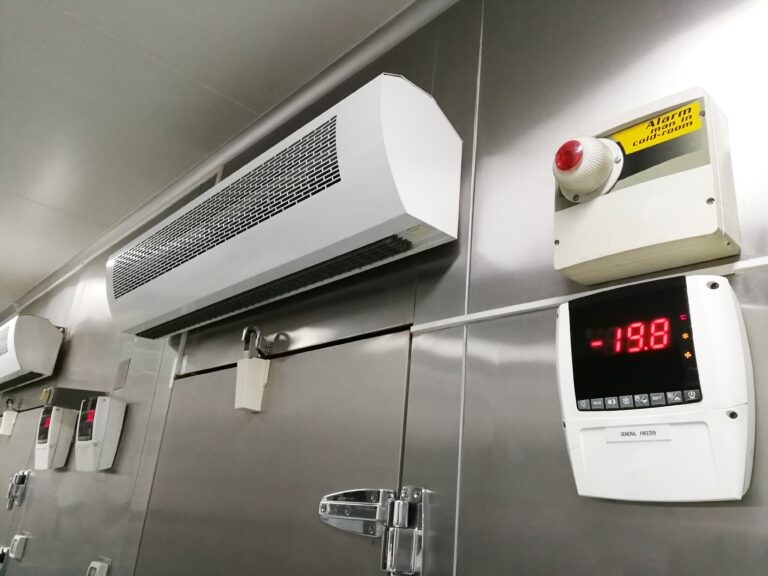To make this measure more effective and tailored to the specific context of your company, we recommend that you first perform an overall analysis of your energy situation.
Controlling the operation and running costs of your company’s cold production system
Cold production is used to cool a room or an element, preserve food products, control the temperature of a process, or activate air conditioning.
Optimising the performance of components and their use leads to significant reductions in electricity consumption. In addition to the cold production unit, this also includes the distribution system and the cooling system.
Definition of requirements with a view to optimising cold production
Analysis of current energy consumption
- Assess the energy consumption of the production unit(s) and the plant periphery.
- Monitor performance indicators and identify any malfunctions.
Identification of the building’s cooling requirements
- Inspection of cold production system(s)
Determination of the various current parameters of the installation, e.g. age, general condition, temperature level, consumption, and associated costs, etc.
- Analysis of heat consumption
- Check the technical limits of the production unit(s)
On the basis of the supplier’s specifications, identify the ideal temperature level and maximum power of the production unit(s)
- Check the set points and flow rates of the various outlets
- Cross-referencing consumption data with cold production indicators
- Visual analysis of the installation
- Visual inspection of the entire periphery of the installation, e.g. pipework, insulation, indoor and outdoor units, equipment room, leaks, etc.
- Check for frequent faults: starting intervals too long, permanent overload, cooling circuit overheating
Further information
The main tasks of a consulting engineering office (technical consultant) or a qualified professional (refrigeration installer) in optimising a cold production system are as follows:
- carry out an inventory of the entire infrastructure
- analyse energy consumption linked to cold production
Implementation of measures to adapt the cold production system
Cold production side
- Maintenance and periodic inspection of the installation by a qualified professional (refrigeration installer)
- Adjust setpoints to actual requirements, in accordance with supplier specifications
- During the cold season and if the production temperature level allows it, take advantage of the by-pass mode (“free-cooling”) which consists of direct cooling by the external cooling circuit
- Checking and, if necessary, adjusting the insulation of all refrigeration components, including the equipment room
- During the winter period, depending on actual requirements, it may be possible to professionally shut down the entire production system (or individual circuits)
Plant periphery
- Regular cleaning of outdoor condensers (cooling towers)
- Check and, if necessary, adjust the flow rate of the various pumps
- Replacement of old pump models with latest-generation pumps allowing flow rate adjustment
Further information
Using waste heat
In principle, cold production is provided by electric compressors. This process releases a high percentage of the energy in the form of waste heat. This heat can be used for other energy purposes, such as preparing domestic hot water, heating production halls, drying materials, etc.
Subsidy application
Government subsidies
Attention: incentive effect to be complied with when applying for subsidies (state or otherwise) and subject to meeting the eligibility conditions.
To respect the “incentive effect”, no binding commitment (signing a quotation; paying a deposit) may be made BEFORE submitting the application file or receiving the agreement in principle from the State or the electricity and natural gas supplier following a subsidy application.
Fit 4 Sustainability” programme:
- The “Fit 4 Sustainability” programme provides co-financing for an environmental audit and action plan on one or more topics chosen by the company (energy, greenhouse gases, waste, water, etc.)
- Subsidies of up to 50 %, 60 % and 70 % of the fees for carrying out an environmental study (energy audit and/or carbon footprint) + detailed, costed action plan to reduce consumption/GHGs (greenhouse gases) (medium- and long-term investment, ROI, etc.) – open to SMEs and large companies (except those required to carry out a statutory audit)
- Any questions? Luxinnovation
- Financial Aid for small and medium-sized enterprises covering up to 70% of eligible costs for the implementation of a project aimed at reducing the environmental impact. The eligible project budget must be in a range from 3.000 € to 25.000 € excl. VAT.
- For more information:
- Chambre des Métiers for craft companies
- Chamber of Commerce for businesses in the non-craft sectors
N.B. State subsidies cannot be combined for the same project.
Application for subsidies from electricity and natural gas suppliers
Since 2015, natural gas and electricity suppliers have been required to make energy savings for consumers under the obligation scheme. Since then, energy suppliers have been offering support and advice, as well as subsidy programmes for consumers to implement energy efficiency measures.
The following suppliers offer this service for companies:
N.B. Supplier subsidies can be combined with any state subsidies for the same project.
Implementation aid
- ITM SST 1314.2 Installation de production de froid fonctionnant au dioxyde de carbone (CO2) (R744)
- ITM-CL 318.2 Tuyauteries métalliques destinées au transport de fluides à l’intérieur d’une entreprise
- ITM-SST 1305.1 Appareils sous pression contenant de l’air comprimé ou des gaz liquéfiés, comprimés ou dissous
